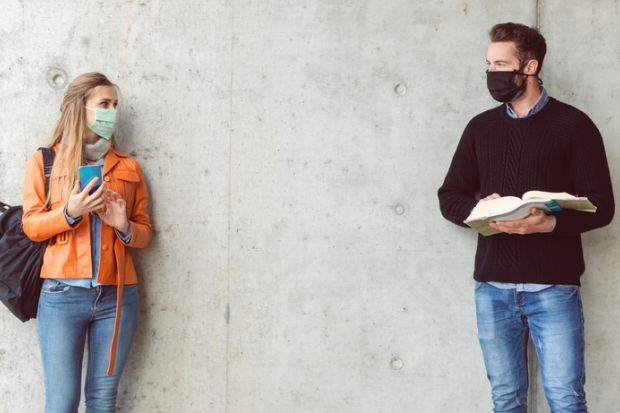The spate of Covid-19 outbreaks among students at the start of the university year may have hit the UK headlines, but it should not have come as a surprise. It was never likely that the mitigation measures put in place to make universities and colleges “Covid-19 secure” would prevent all infection.
Most of the outbreaks are linked to student household settings and social activities, but it would be unfair to demonise students. Far from aberrant, their behaviour is in keeping with normal behaviour for most young adults. In addition, it mirrors low levels of public compliance with public health guidance – a recent survey found that only 18 per cent of adults with Covid-19 symptoms adhered to social-isolation advice.
Still, while it may be too late to avert the initial rash of infections, there is still value in preparing and implementing measures for the rest of the academic year – particularly given the Academy of Medical Sciences’ warning of a worsening epidemic in the UK, potentially peaking between January and March.
Eliminating community transmission would require all courses to go fully online for at least the next six to 12 months, until the risk of Covid has abated. If the aim is for “mitigation”, this implies acceptance by staff, students and parents that there will be transmission in the university community; the risk of contracting Covid-19 would depend on individual vulnerability (such as age, ethnicity or pre-existing conditions), activity (such as close contact or aerosol-generating activity), setting (such as ventilation level), background community infection levels and the efficacy of control measures.
So what should universities and colleges do? First, they should earn the support and compliance of the wider student and staff body regarding local control measures. This requires open dialogue and co-production of the new norms. Sensible measures advised by both the government’s Scientific Advisory Group for Emergencies (Sage) and the alternative Independent Sage include the segmentation of students where possible and the ubiquitous use of face coverings, including in all teaching settings.
Second, universities should fully implement the “find, test, trace, isolate, support” approach. There is a lot of focus on testing to identify cases, but waiting for test results when the affected individuals are most infectious is unwise. Moreover, the accessibility of tests for unwell students is a worry, especially if it requires them to travel miles to a test site. The chain of infection is better tackled by focusing on early detection (the “find” part of the above formula) and implementation of self-isolation of the individual and pre-emptive quarantine of their household.
Based on their symptoms, cases are classified as “possible” or “probable” (they are “confirmed” only after laboratory analysis). Disease-control measures are tailored accordingly. Possible cases (unwell students with symptoms that don’t quite fit the Covid-19 definition) should self-isolate immediately until their symptoms resolve or the diagnosis becomes clear. Probable cases (unwell students with Covid-19 symptoms awaiting confirmatory test results) should be assumed to be positive, and the individual and their household should be instructed to self-isolate immediately. Early action could make the difference in avoiding larger outbreaks.
Having a local contact-tracing system may speed up the identification of cases, especially if it is initiated on “probable” cases. The government’s Test and Trace system only carries out contact tracing for test-confirmed cases.
There are some who advocate for mass testing in university settings. However, there are significant issues with this approach. The national testing system aims to deliver 500,000 tests a day by the end of October: 3.5 million a week. For a university town such as Sheffield, which has roughly 1 per cent of the national population, this equates to 35,000 tests a week. However, the number of staff and students at the city’s universities and colleges alone exceeds 60,000. So it is evident that the national system lacks the capacity to provide higher education with weekly testing.
There are also inherent problems with mass testing. There is no perfect test, and all tests will produce false negatives and false positives. Individuals with false-positive results end up isolating unnecessarily, which is disruptive to them and their classes. False negatives may erroneously reassure infected individuals, who may then unwittingly spread the infection to others.
Perhaps the most contentious option to consider is whether to accept a higher level of infection on campuses than elsewhere, on the basis that the risk to most students and staff is low. According to the Office for National Statistics, the risk of death for people between the ages of 15 and 24 is one in 218,399, and one in 34,354 for those between 25 and 44, compared with an overall average of one in 1,318.
The bottom line is this. Whatever higher education institutions do, further Covid outbreaks will happen. It is not a question of if they will occur, but rather when they will occur and how extensive they will be. So if universities and colleges want to stay open, it means accepting a level of risk and implementing measures to contain it as much as possible.
Andrew Lee is a reader in global public health at the University of Sheffield.
Register to continue
Why register?
- Registration is free and only takes a moment
- Once registered, you can read 3 articles a month
- Sign up for our newsletter
Subscribe
Or subscribe for unlimited access to:
- Unlimited access to news, views, insights & reviews
- Digital editions
- Digital access to THE’s university and college rankings analysis
Already registered or a current subscriber? Login









